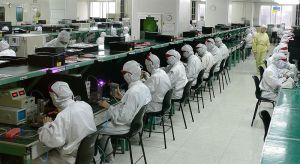As reported on TechCrunch.
by JON EVANS

Don’t look now, but something remarkable is happening.
Instagram had twelve employees when it was purchased for $700 million; all of its actual computing power was outsourced to Amazon Web Services. Mighty ARM has only 2300 employees, but there are more than 35 billion ARM-based chips out there. They do no manufacturing; instead they license their designs to companies like Apple, who in turn contract with companies like TSMC for the actual fabrication. Nest Labs and Ubiquiti are both 200-employee hardware companies worth circa $1 billion…who subcontract their actual manufacturing out to China.
Warren Buffett has long advocated investing in businesses with “moats” around their business model. Often that moat is an economy of scale; the notion that a hundred widgets cost a dollar each but a million widgets only a dime apiece.
Obviously that doesn’t apply to software, or music, or other virtual goods. What’s less obvious is that as time goes by, and technology and interconnectivity advance, it applies less and less to the physical world as well. Industrial capacities that not long ago were available only to gargantuan corporations are today open to anyone and everyone. Amazon, Microsoft, Google, and the OpenStack providers compete to rent economies of scale for web services. Foxconn et al essentially do the same for electronics. So what happens when this trend expands into other sectors? What happens when there are Foxconns for furniture, or cars, or houses, or retail stores? And a Dronenet for transporting physical goods?
What happens is that moats dry up, and are bridged, and previously impregnable incumbents start looking very vulnerable to disruption indeed.
But wait. This is all too small. Let’s think bigger yet.
Compare and contrast Intel with ARM. The former is, historically, a vertically integrated design-and-manufacturing monolith which owns and controls everything they do, whereas the latter concentrates on being the best at the one thing they do. I have enormous respect for Intel but itseems clear that the world is trending towards ARM’s more decoupled model, wherein their designs (like TSMC’s manufacturing capacity) are made available to any and all customers.
The logical conclusion of that trend, however, is far more transformative than a mere reduction in optimal corporate size and scope: it’s this–
I might paraphrase that as “property isn’t theft; property is an inefficient distribution of resources.” It signifies a dichotomy between two very different modes of thinking–one where you own things, and one where you just use them, and share them when they’re not in use. This is old news in the tech world, which has been dispersing monolithic dedicated channels into hordes of flexibly routed packets for decades…
Fibers always come in pairs. This practice seems obvious to a telephony person, who is in the business of setting up symmetrical two-way circuits, but makes no particular sense to a hacker tourist who tends to think in terms of one-way packet transmission. The split between these two ways of thinking runs very deep and accounts for much tumult in the telecom world.
— Neal Stephenson, Mother Earth Mother Board, 1994
…but it’s enormously foreign and disruptive, verging on revolutionary, to most everyone else. (Indeed, a whole lot of people have probably just mistaken it for communism. It’s not.)
We’re getting pretty abstract here. Let me pick a particular example: this column by Casey B. Mulligan in the New York Times this week, which concludes that “driverless cars … will increase the number of vehicles on the road.”
It’s a fairly smart piece that suffers from what I call “unidimensional extrapolation,” and so misses effects like the trend I refer to above. Widespread use of driverless cars will inevitably lead to a sharp rise in ownerless cars. A major reason for owning a car is that you don’t need to go get one when you need one. Which sounds like a tautology today, but won’t when shared driverless cars will be able to zoom to your house on five minute’s notice when you need to go to the mall for an hour.
Ultimately, I’m confident that driverless cars will lead to much lower car ownership in urban areas; instead, large numbers of people will have fractional ownership of sizable pools of driverless vehicles, à la Berkshire Hathaway’s NetJets, and just summon them when they need them. This will codify and formalize the running cost of using a car…and since you won’t pay for them when you’re not using them, it in turn will lead to fewer cars on the road.
That’s just one example. More generally, I think it’s hard to deny that both industries (AWS, Foxconn, etc) and individuals (from AirBNB to Zipcar) are increasingly moving towards collective usage of large pools of widely accessible shared resources. Economies of scale as a service, as Aaron put it. So far the effects are limited to specific sectors and domains — but it’s only a matter of time before this wave of change reaches, and profoundly disturbs, entire industries hitherto untouched by its force.